Analytical Non-Stationary Satellite to Aircraft Channel Modeling over Open Area Based on Regular Shaped Geometry-Based Stochastic Model
Abstract
1. Introduction
1.1. Related Work
1.2. Motivation and Contributions of This Paper
- The time variant geometrical structure of the S2A system including a ellipsoidal ground scattering region is presented with regional UD of the ground scatterers.
- An analytical non-stationary channel model is developed, including three paths, i.e., the LOS path, the ground specular reflection path, and the ground scattering path. Non-stationary and stationary analytical expressions of channel impulse responses (CIRs), transfer functions (TFs), auto-correlation functions (ACFs), and power spectrum density (PSD) are derived.
- The non-stationary characteristics of the channel is observed through the simulation of CIRs, TFs, ACFs, PSD, and etc.
- Based on the UD assumption of the scatterers, distributions of the path attenuation, the time delay, and the Doppler shift of the scattering path are derived, simulated, and fitted.
2. The Geometrical Structure
3. Analytical Non-Stationary S2A Channel Model
3.1. Channel Impulse Response
3.2. Time Variant Transfer Function
3.3. Time-Frequency ACFs
4. Distributions of Path Delay, Path Attenuation, Normalized Doppler Shift of the Scattering Path
4.1. The Distribution of
4.2. The Distribution of
4.3. The Distribution of
5. Simulation Results and Analysis
5.1. Simulation Assumptions
5.2. Simulations of CIR, TF, ACF, and Normalized Doppler PSD
5.3. Simulations of the Distributions of Path Delay, Path Attenuation, and Normalized Doppler Shift of the Scattering Path
5.3.1. The Distribution of
5.3.2. The Distribution of
5.3.3. The Distribution of
6. Conclusions
Author Contributions
Funding
Conflicts of Interest
Appendix A. Examples of Area Calculation Error of the Scattering Ellipse
| Scenario | Precise Area (m2) | Approximate Area (m2) | Calculation Error (%) |
|---|---|---|---|
| Rising t = 0 s | 5.3767 × 105 | 5.3729 × 105 | 0.071 |
| Rising t = 700 s | 6.0180 × 106 | 6.0178 × 106 | 0.0023 |
| Cruising t = 0 s | 1.4728 × 107 | 1.4728 × 107 | 0.0026 |
| Cruising t = 900 s | 1.4651 × 107 | 1.4651 × 107 | 0.00064 |
Appendix B. The Calculation of l1,T (τDIF, t) and ls,T (τDIF, t)
References
- Jost, T.; Pelzmann, T.; Schwinzerl, M.; Walter, M.; Schonhuber, M.; Floury, N. Using airborne measurements to model the satellite-to-aircraft channel model at L-band. In Proceedings of the 2017 11th European Conference on Antennas and Propagation (EUCAP), Paris, France, 19–24 March 2017; pp. 1448–1451. [Google Scholar] [CrossRef]
- Bello, P.A. Aeronautical Channel Characterization. IEEE Trans. Commun. 1973, 21, 548–563. [Google Scholar] [CrossRef]
- Cid, E.L.; Sanchez, M.G.; Alejos, A.V.; Fernandez, S.G. Measurement, Characterization, and Modeling of the Helicopter Satellite Communication Radio Channel. IEEE Trans. Antennas Propag. 2014, 62, 3776–3785. [Google Scholar]
- Pelzmann, T.; Jost, T.; Schwinzerl, M.; Pérez-Fontán, F.; Schönhuber, M.; Floury, N. Airborne measurements enhancing the satellite-to-aircraft channel model in L-band. In Proceedings of the 2016 10th European Conference on Antennas and Propagation (EuCAP), Davos, Switzerland, 10–15 April 2016; pp. 1–5. [Google Scholar] [CrossRef]
- Jia, R.; Li, Y.; Cheng, X.; Ai, B. 3D geometry-based UAV-MIMO channel modeling and simulation. China Commun. 2018, 15, 64–74. [Google Scholar]
- Schneckenburger, N.; Jost, T.; Walter, M.; Del Galdo, G.; Matolak, D.W.; Fiebig, U. Wideband Air-Ground Channel Model for a Regional Airport Environment. IEEE Trans. Veh. Technol. 2019, 68, 6243–6256. [Google Scholar] [CrossRef]
- Gulfam, S.M.; Syed, J.N.; Ahmed, A.; Patwary, M.N.; Ni, Q. A Novel 3D Analytical Scattering Model for Air-to-Ground Fading Channels. Appl. Sci. 2016, 6, 207. [Google Scholar] [CrossRef]
- Zhu, Q.; Jiang, K.; Chen, X.; Zhong, W.; Yang, Y. A novel 3D non-stationary UAV-MIMO channel model and its statistical properties. China Commun. 2018, 15, 147–158. [Google Scholar]
- Yan, C.; Fu, L.; Zhang, J.; Wang, J. A Comprehensive Survey on UAV Communication Channel Modeling. IEEE Access 2019, 7, 107769–107792. [Google Scholar] [CrossRef]
- Khawaja, W.; Guvenc, I.; Matolak, D.W.; Fiebig, U.; Schneckenberger, N. A Survey of Air-to-Ground Propagation Channel Modeling for Unmanned Aerial Vehicles. IEEE Commun. Surv. Tutor. 2019, 21, 2361–2391. [Google Scholar] [CrossRef]
- Kunisch, J.; de la Torre, I.; Winkelmann, A.; Eube, M.; Fuss, T. Wideband time-variant air-to-ground radio channel measurements at 5 GHz. In Proceedings of the 5th European Conference on Antennas and Propagation (EUCAP), Rome, Italy, 11–15 April 2011; pp. 1386–1390. [Google Scholar]
- Chang, H.; Bian, J.; Wang, C.; Bai, Z.; Zhou, W.; Aggoune, E.M. A 3D Non-Stationary Wideband GBSM for Low-Altitude UAV-to-Ground V2V MIMO Channels. IEEE Access 2019, 7, 70719–70732. [Google Scholar] [CrossRef]
- Dahech, W.; Patzold, M.; Gutierrez, C.A.; Youssef, N. A Non-Stationary Mobile-to-Mobile Channel Model Allowing for Velocity and Trajectory Variations of the Mobile Stations. IEEE Trans. Wirel. Commun. 2017, 16, 1987–2000. [Google Scholar] [CrossRef]
- Borhani, A.; Stsber, G.L.; Ptzold, M. A Random Trajectory Approach for the Development of Nonstationary Channel Models Capturing Different Scales of Fading. IEEE Trans. Veh. Technol. 2017, 66, 2–14. [Google Scholar]
- Zhang, X.; Liu, J.; Gu, F.; Ma, D.; Wei, J. An Extended 3-D Ellipsoid Model for Characterization of UAV Air-to-Air Channel. In Proceedings of the ICC 2019—2019 IEEE International Conference on Communications (ICC), Shanghai, China, 20–24 May 2019; pp. 1–6. [Google Scholar] [CrossRef]
- Walter, M.; Shutin, D.; Dammann, A.; Matolak, D.W. Modeling of Highly Non-Stationary Low Altitude Aircraft-to-Aircraft Channels. In Proceedings of the MILCOM 2018—018 IEEE Military Communications Conference (MILCOM), Los Angeles, CA, USA, 29–31 October 2018; pp. 1–5. [Google Scholar] [CrossRef]
- Walter, M.; Shutin, D.; Matolak, D.W.; Schneckenburger, N.; Wiedemann, T.; Dammann, A. Analysis of Non-Stationary 3D Air-to-Air Channels Using the Theory of Algebraic Curves. IEEE Trans. Wirel. Commun. 2019, 18, 3767–3780. [Google Scholar] [CrossRef]
- Walter, M.; Schnell, M. The Doppler-Delay Characteristic of the Aeronautical Scatter Channel. In Proceedings of the 2011 IEEE Vehicular Technology Conference (VTC Fall), San Francisco, CA, USA, 5–8 September 2011; pp. 1–5. [Google Scholar] [CrossRef]
- Walter, M.; Shutin, D.; Fiebig, U. Prolate Spheroidal Coordinates for Modeling Mobile-to-Mobile Channels. IEEE Antennas Wirel. Propag. Lett. 2015, 14, 155–158. [Google Scholar] [CrossRef]
- Walter, M.; Shutin, D.; Dammann, A. Time-Variant Doppler PDFs and Characteristic Functions for the Vehicle-to-Vehicle Channel. IEEE Trans. Veh. Technol. 2017, 66, 10748–10763. [Google Scholar] [CrossRef]
- Walter, M.; Shutin, D.; Fiebig, U. Delay-Dependent Doppler Probability Density Functions for Vehicle-to-Vehicle Scatter Channels. IEEE Trans. Antennas Propag. 2014, 62, 2238–2249. [Google Scholar] [CrossRef]
- Wagner, C.; Klokocni, J. The value of ocean reflections of GPS signals to enhance satellite altimetry: Data distribution and error analysis. J. Geod. 2003, 77, 128–138. [Google Scholar] [CrossRef]
- Jianfeng, S.; Xiaozhen, L. Discussion on the value of effective factor of earth radius in the calculation of radio wave propagation. J. Time Freq. 2010, 33, 32–38. [Google Scholar]
- Graziani, A.; Vanhoenackerjanvier, D.; Pereira, C.; Riva, C.; Vergani, A.; Lemorton, J. Synthetized tropospheric total attenuation time series for satellite-to-aeronautical link from L to Q band. In Proceedings of the 2016 10th European Conference on Antennas and Propagation (EuCAP), Davos, Switzerland, 10–15 April 2016. [Google Scholar]
- Cazzani, L.; Colesanti, C.; Leva, D.; Nesti, G.; Prati, C.; Rocca, F.; Tarchi, D. A ground-based parasitic SAR experiment. IEEE Trans. Geosci. Remote Sens. 2002, 38, 2132–2141. [Google Scholar] [CrossRef]
- Klein, L.; Swift, C. An improved model for the dielectric constant of sea water at microwave frequencies. IEEE Trans. Antennas Propag. 1977, 25, 104–111. [Google Scholar] [CrossRef]
- Meissner, T.; Wentz, F.J. The Complex Dielectric Constant of Pure and Sea Water from Microwave Satellite Observations. IEEE Trans. Geosci. Remote Sens. 2004, 42, 1836–1849. [Google Scholar] [CrossRef]
- Guan, K.; He, D.; Ai, B.; Matolak, D.W.; Wang, Q.; Zhong, Z.; Kürner, T. 5-GHz Obstructed Vehicle-to-Vehicle Channel Characterization for Internet of Intelligent Vehicles. IEEE Internet Things J. 2019, 6, 100–110. [Google Scholar] [CrossRef]
- Weihua, B. Study of the GNSS-R Ocean Remote Sensing Technique. Ph.D. Thesis, Chinese Academy of Sciences, Beijing, China, 2008. [Google Scholar]
- Yongxing, B. Study on Soil Moisture Remote Sensing Using GNSS-R Signals. Master’s Thesis, Beihang University, Beijing, China, 2013. [Google Scholar]
- Molisch, A.F. Wireless Communications; JOHN WILEY & SONS: Chichester, UK, 2011. [Google Scholar]
- Kobayashi, H.; Mark, B.L.; Turin, W. Probability, Random Processes, and Statistical Analysis; Cambridge University Press: Cambridge, UK, 2012. [Google Scholar]
- Haas, E. Aeronautical channel modeling. IEEE Trans. Veh. Technol. 2002, 51, 254–264. [Google Scholar] [CrossRef]
- Hoeher, P.; Haas, E. Aeronautical channel modeling at VHF-band. In Proceedings of the 1999 IEEE Vehicular Technology Conference (VTC Fall), Amsterdam, The Netherlands, 19–22 September 1999; pp. 1961–1966. [Google Scholar] [CrossRef]
- Fazli, E.H.; Werner, M. View Angle Statistics of Aircraft Airborne Antenna to GEO Satellites. In Proceedings of the 2009 International Workshop on Satellite and Space Communications, Tuscany, Italy, 9–11 September 2009. [Google Scholar]
- Zhu, Q.; Yang, Y.; Wang, C.; Tan, Y.; Sun, J.; Chen, X.; Zhong, W. Spatial Correlations of a 3-D Non-Stationary MIMO Channel Model With 3-D Antenna Arrays and 3-D Arbitrary Trajectories. IEEE Wirel. Commun. Lett. 2019, 8, 512–515. [Google Scholar] [CrossRef]
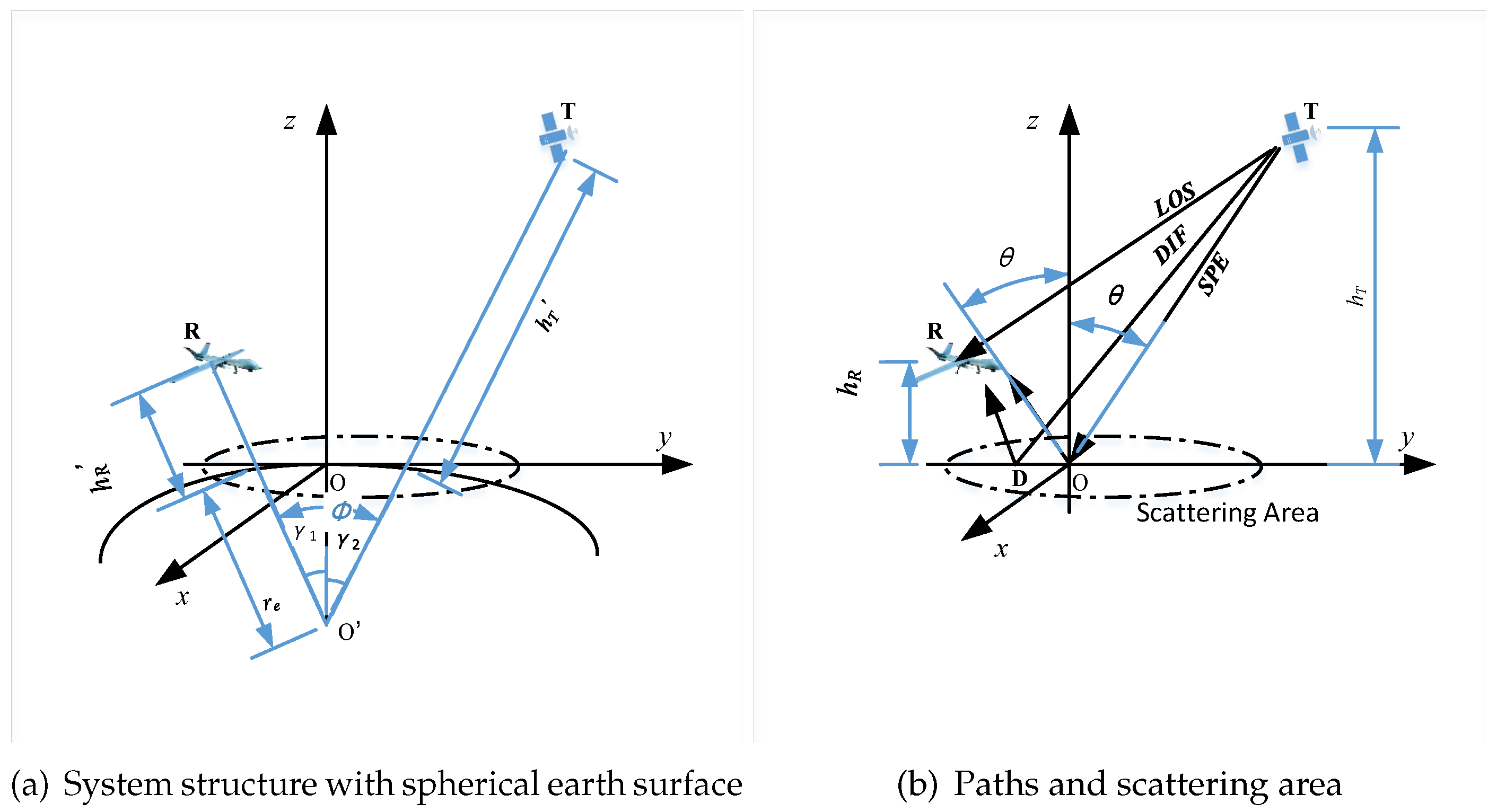


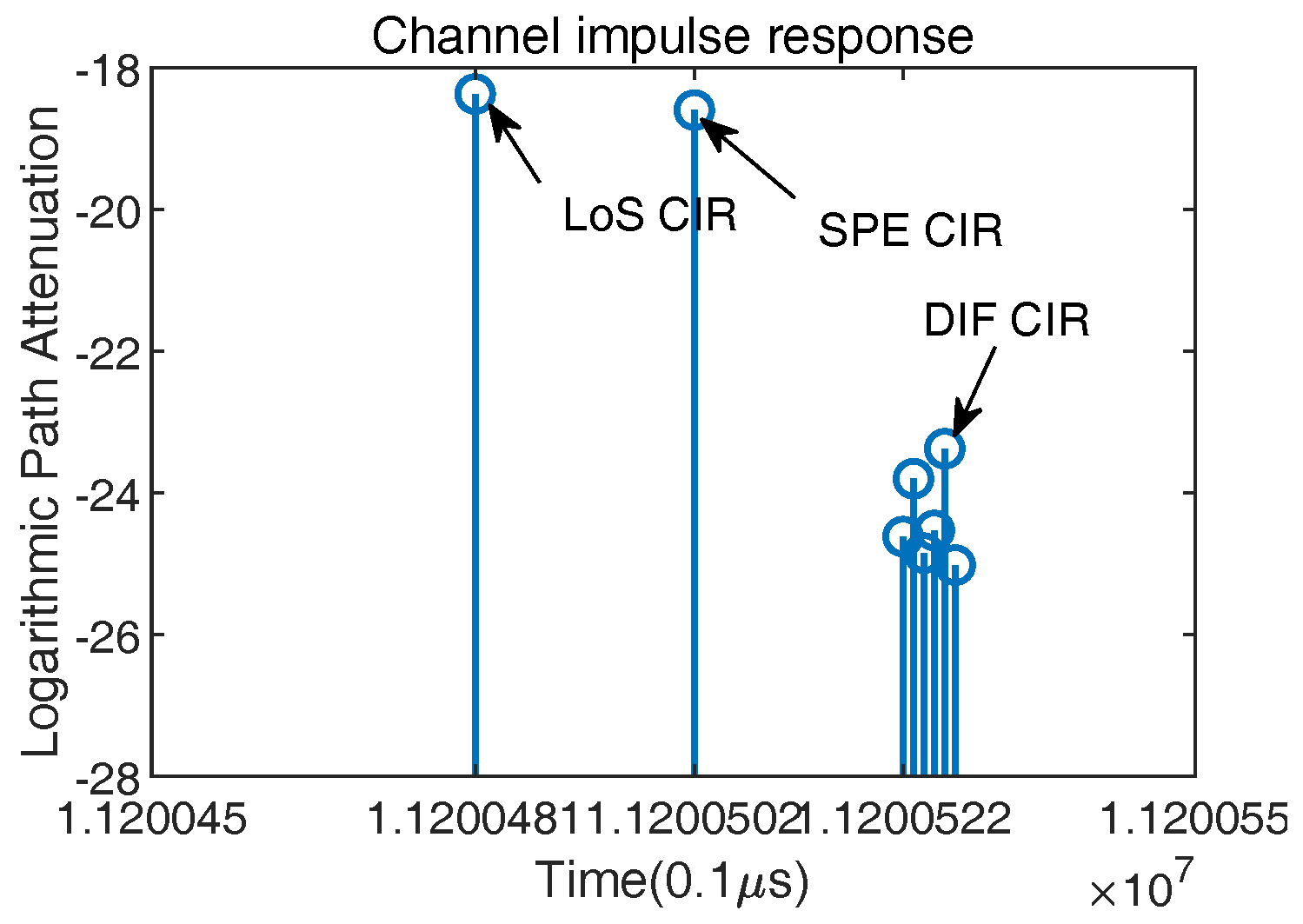
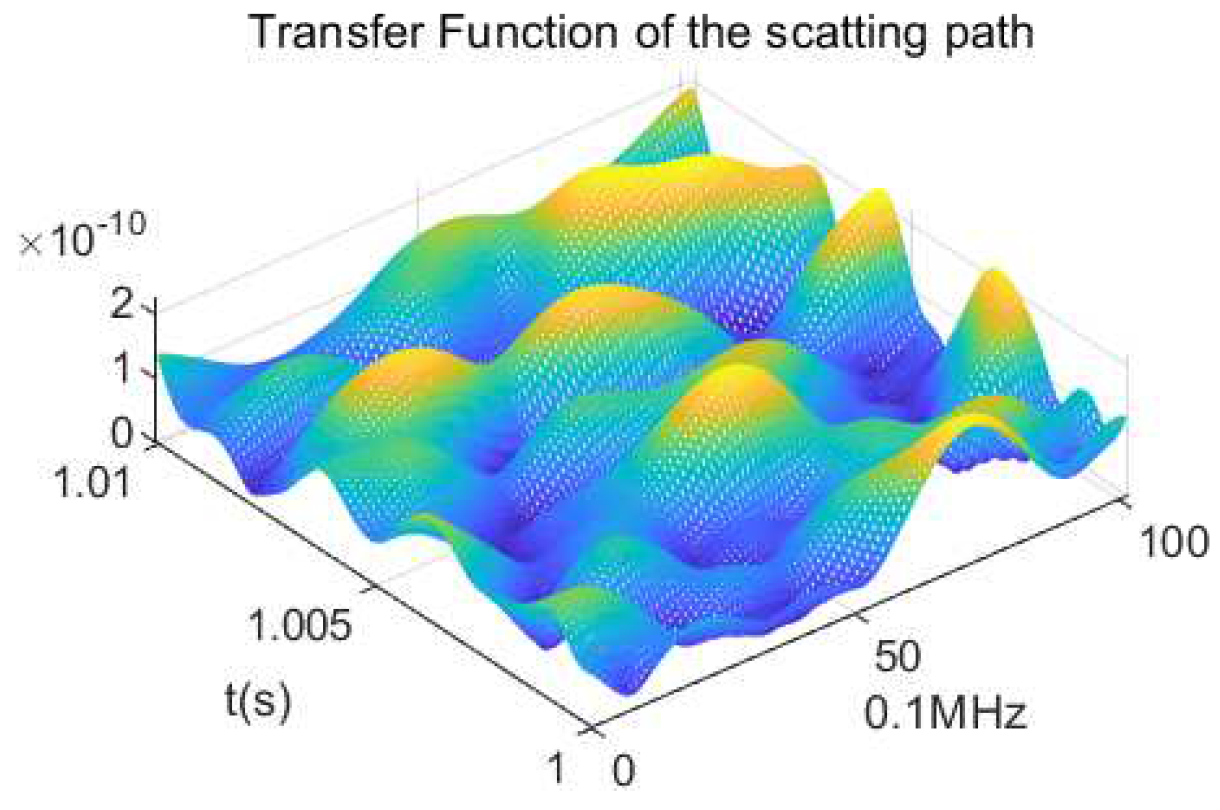

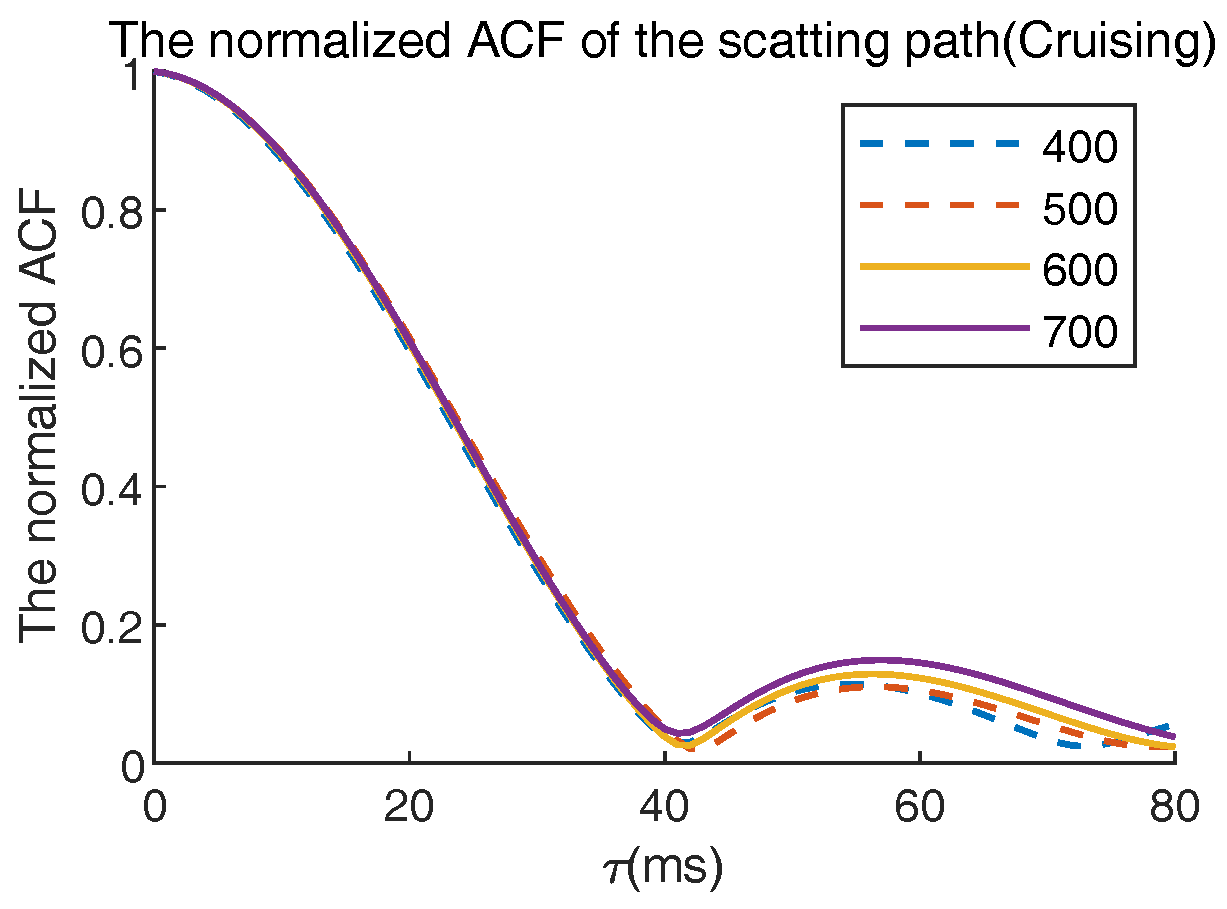

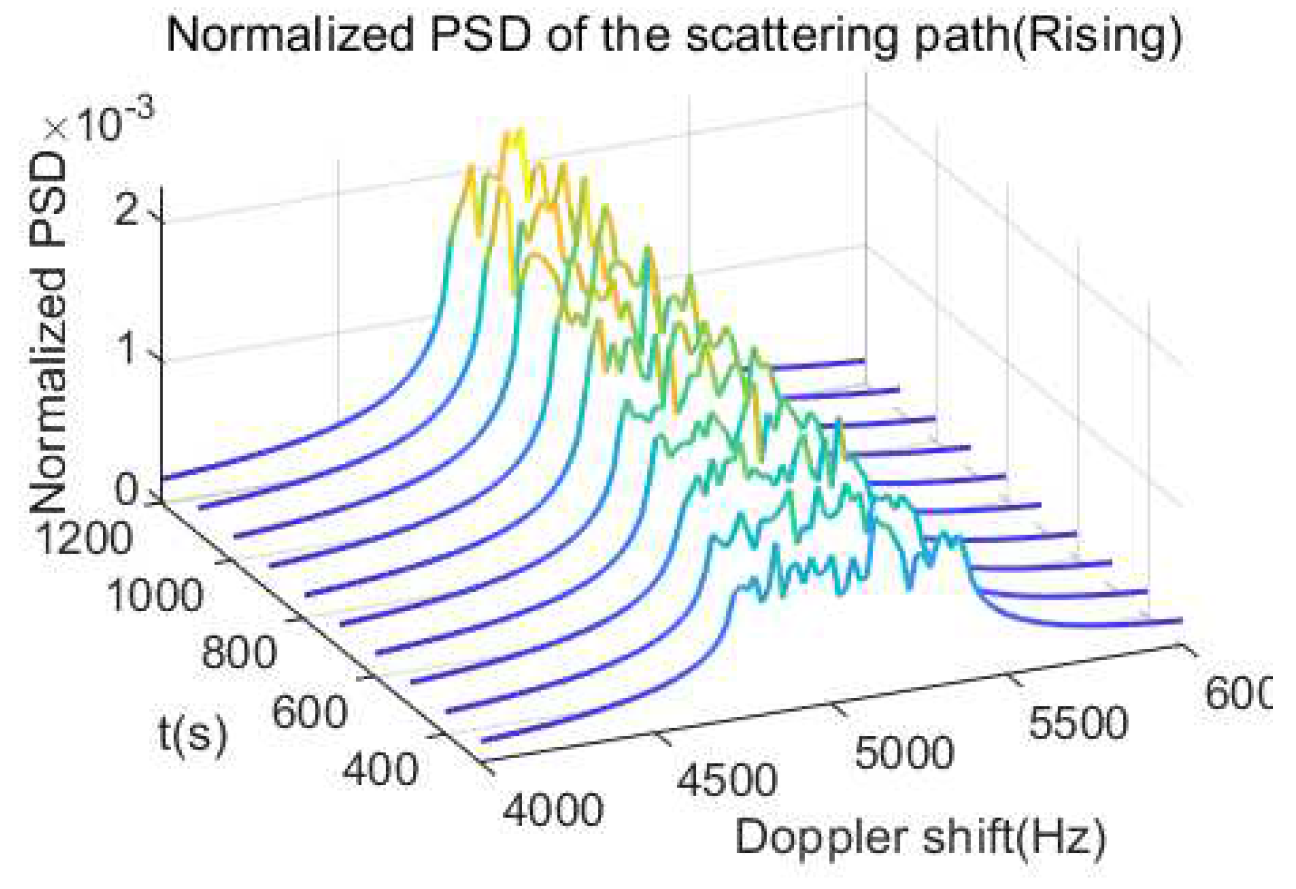
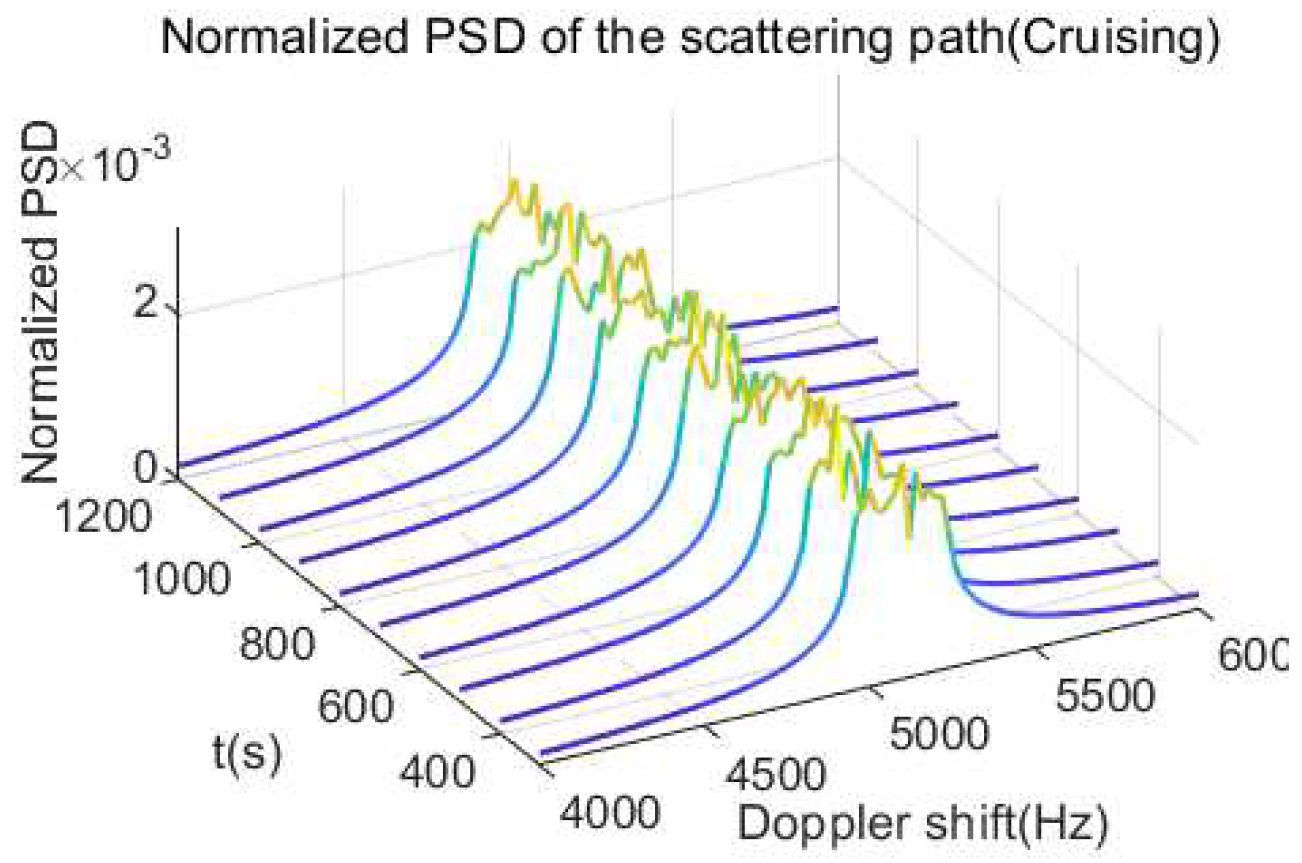
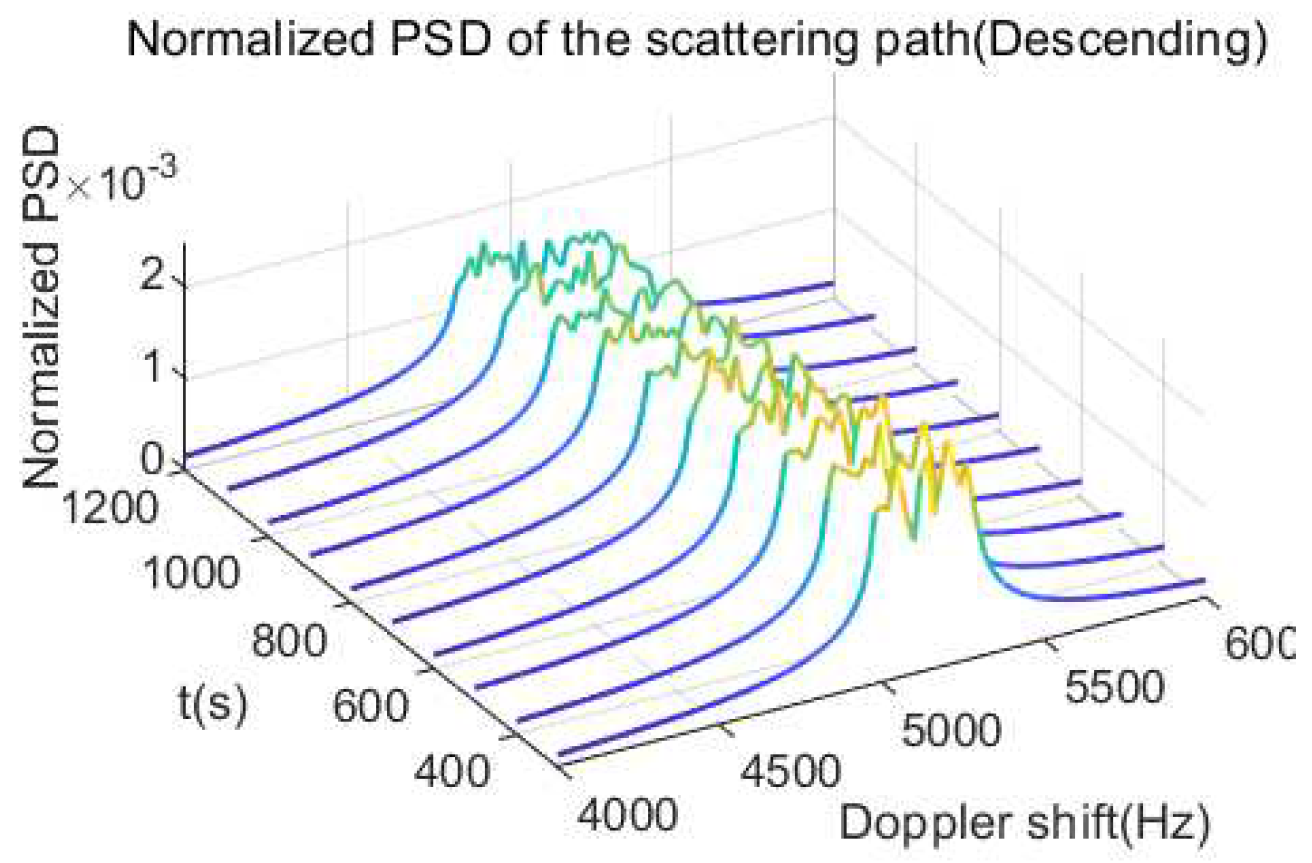
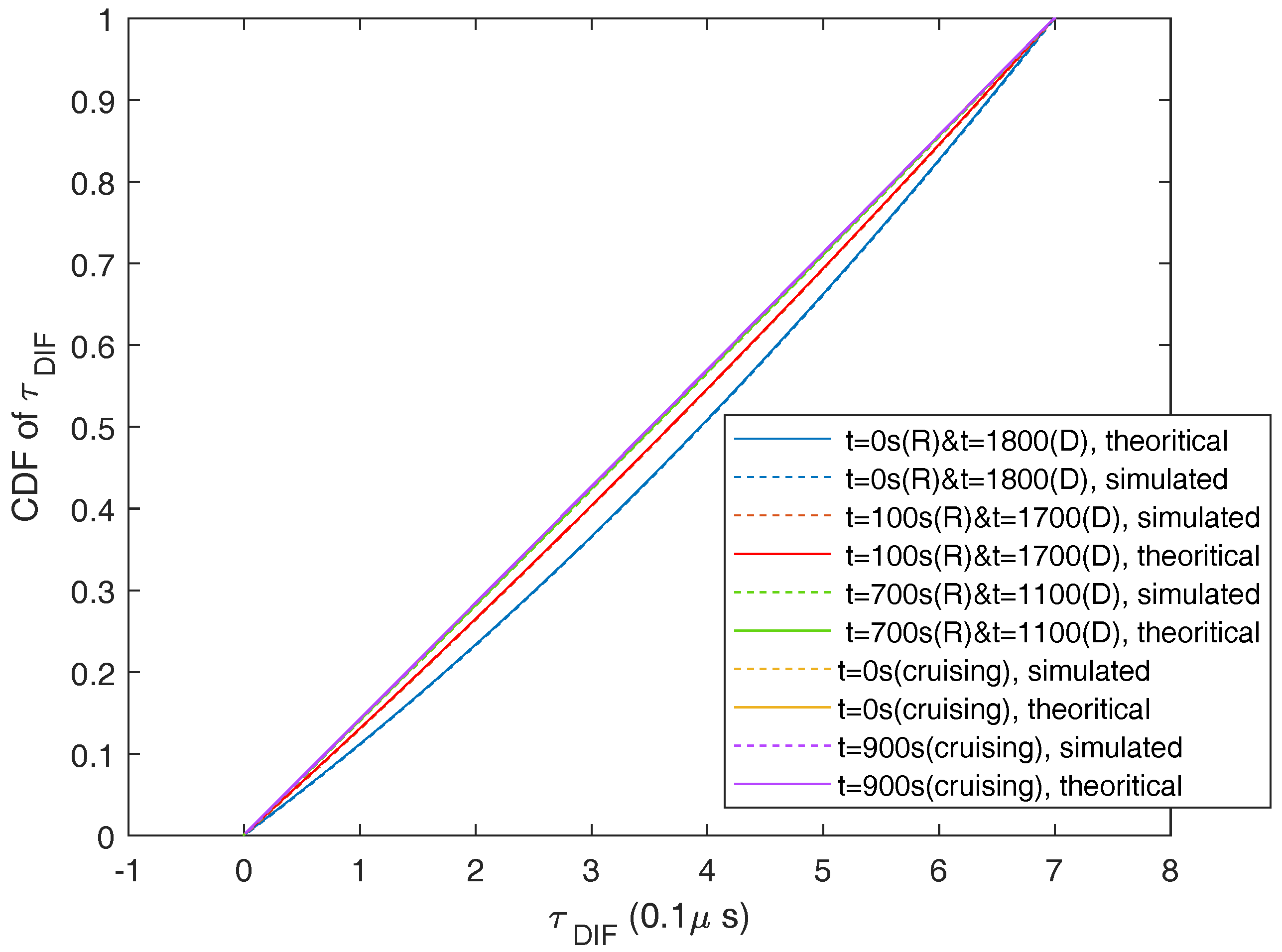
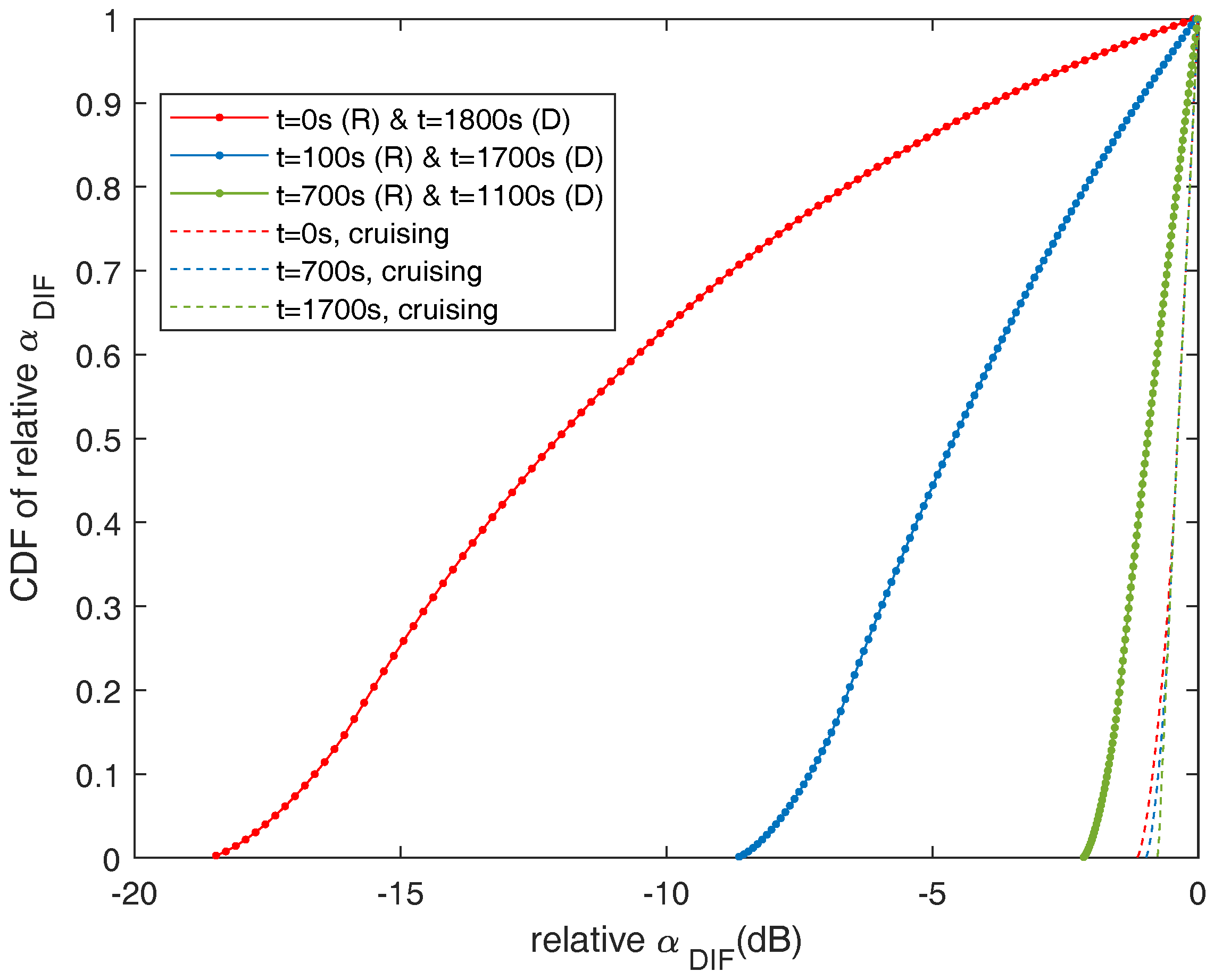


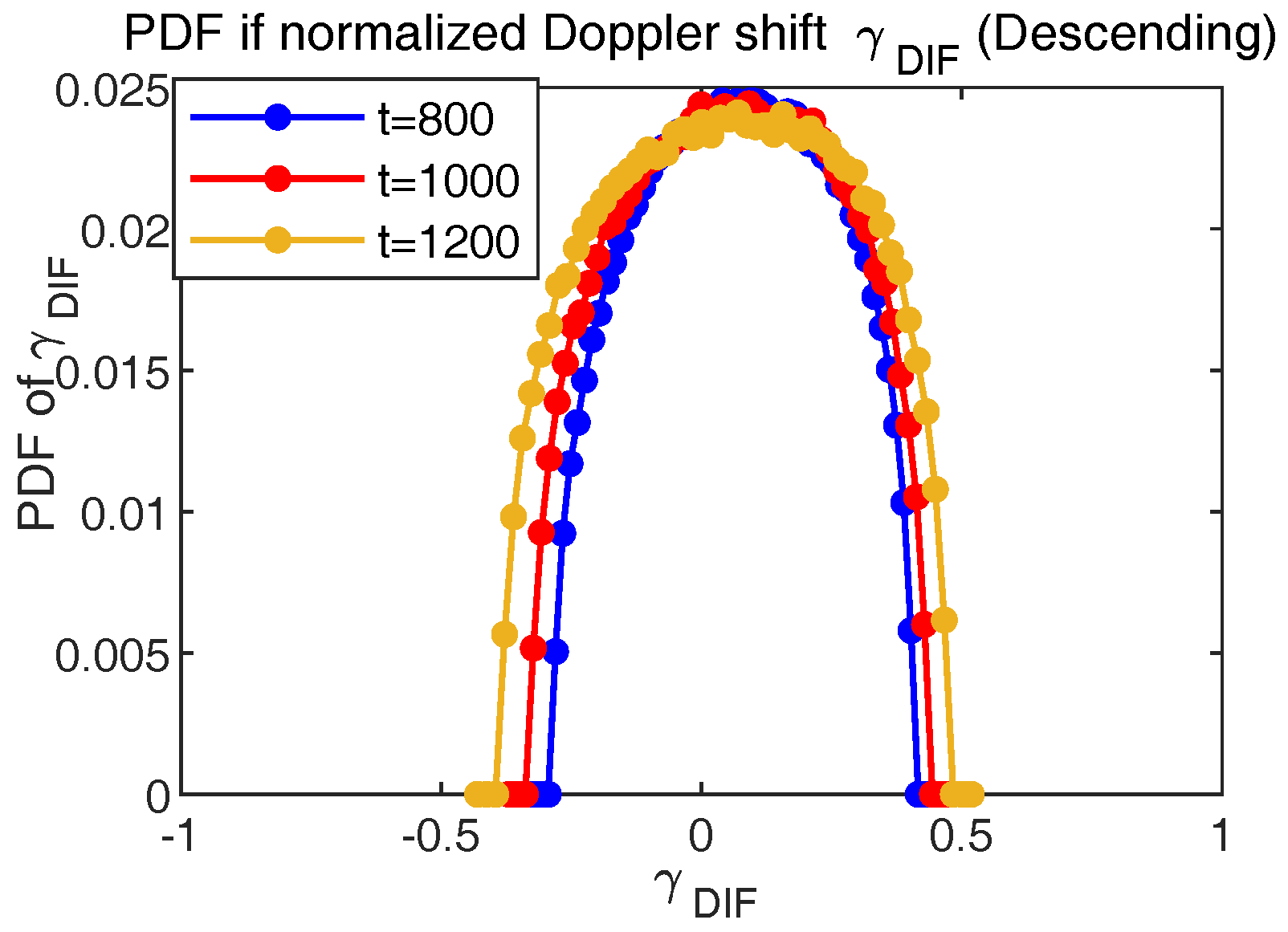
| Symbol | Definition |
|---|---|
| c | The speed of light |
| D | The scatterer |
| Time variant distance between the transmitter and the receiver (length of the LOS path). | |
| The time variant length of the specular reflection path | |
| The time variant distance between the transmitter T and the specular reflection point O | |
| The time variant distance between the specular reflection point O and the receiver R | |
| The time variant length of the lth scattering sub-path. | |
| f | Frequency |
| The antenna gain of the receiver at the moment t along the LOS path | |
| The antenna gain of the receiver at the moment t along the LOS path | |
| The antenna gain of the receiver at the moment t along the specular reflection path | |
| The antenna gain of the receiver at the moment t along the specular reflection path | |
| The antenna gain of the receiver at the moment t along the specular reflection path | |
| The antenna gain of the receiver at the moment t along the specular reflection path | |
| ’ | The altitude of the receiver |
| The time variant altitude of the receiver | |
| ’ | The altitude of the transimitter |
| The time variant altitude of the transimitter | |
| The height of the transimitter | |
| The height (the Z coordinate of R) | |
| The height (the Z coordinate of R) | |
| The height (the Z coordinate of T) | |
| The time variant height (the Z coordinate of T) | |
| CIR of the channel | |
| CIR of the LOS path | |
| CIR of the specular reflection path | |
| CIR of the scattering path | |
| The length of the half major aix of the scattering ellipse | |
| The length of the half minor aix of the scattering ellipse | |
| L | Number of the scatterers |
| The unity directional vector of the LOS path from the transmitter towards the receiver | |
| The unit directional vector towards O observed from T | |
| The unit directional vector towards O observed from R | |
| The unit directional vector towards the lth scatterer observed from the transmitter T | |
| The unit directional vector towards the lth scatterer observed from the receiver R | |
| O’ | The center of the earth |
| O | The origin of the XOY plane, also the specular reflection point |
| The radius of the earth | |
| R | The receiver (aircraft) |
| The time variant area of the scattering ellipse | |
| t | Time |
| T | The transmitter (satellite) |
| Time variant velocity vector of the receiver | |
| Time variant velocity vector of the transmitter | |
| Norm of time variant velocity vector of the receiver | |
| Norm of time variant velocity vector of the transmitter | |
| The time variant 3D coordinate of the transmitter | |
| The time variant 3D coordinate of the receiver | |
| The time variant 3D coordinate of the scatterer | |
| The time variant 3D coordinate of the lth scatterer | |
| Path attenuation of the LOS path | |
| Path attenuation of the specular reflection path | |
| Path attenuation of the scattering path | |
| Path attenuation of the lth scattering path | |
| Time interval | |
| Frequency interval | |
| Relative dielectric permeittivity | |
| The angle between O’R and Z axis | |
| The angle between O’T and Z axis | |
| Time variant reflection coefficient | |
| Time variant reflection for vertical polarization | |
| Time variant reflection coefficient for horizontal polarization | |
| Normalized Doppler shift of the scattering path | |
| The geocentric angle between T (the satellite) and R (the aircraft) | |
| The geocentric angle between T (the satellite) and R (the aircraft) | |
| Additional phase shift of the lth scattering path | |
| Radar cross section (RCS) | |
| Delay | |
| Time variant path delay of the LOS path at the moment t | |
| Time variant path delay of the specular reflection path at the moment t | |
| Time variant path delay of the scattering path at the moment t | |
| Time variant path delay of the lth scattering path at the moment t | |
| Reflection angle | |
| Time variant reflection angle |
| Parameter | Value |
|---|---|
| Altitude of the transmitter | 36,000 km |
| Initial altitude of the receiver (Rising, s) | 300 m |
| Initial altitude of the receiver (Cruising, s) | 11 km |
| Initial altitude of the receiver (Descending, s) | 11 km |
| Initial horizontal distance between the transmitter and the receiver | 400 km |
| Central frequency | 2 GHz |
| Ground velocity vector of the receiver (Rising) | |
| Ground velocity vector of the receiver (Cruising) | |
| Ground velocity vector of the receiver (Descending) | |
| Tap interval | 0.1 μs |
| Number of taps | 7 |
| number of scatterers L in CIR simulation | 100 |
| number of scatterers L in CDF/PDF simulation | 1 × 109 |
| , | 15 dBi omini-directional |
| Cases | Coefficients | Range of Relative |
|---|---|---|
| Rising s & Decending s | , , , , , | |
| Rising s & Decending s | , , , , , | |
| Rising s & Decending s | , , , , , |
| t | Fitting Functions | Coefficients |
|---|---|---|
| s | Polynomial | , , , , |
| s | Polynomial | , , , , |
| s | Polynomial | , , ,, |
© 2020 by the authors. Licensee MDPI, Basel, Switzerland. This article is an open access article distributed under the terms and conditions of the Creative Commons Attribution (CC BY) license (http://creativecommons.org/licenses/by/4.0/).
Share and Cite
Wei, Z.; Tang, Q.; Geng, J.; Chen, S.; Sang, L.; Yang, H. Analytical Non-Stationary Satellite to Aircraft Channel Modeling over Open Area Based on Regular Shaped Geometry-Based Stochastic Model. Appl. Sci. 2020, 10, 5041. https://doi.org/10.3390/app10155041
Wei Z, Tang Q, Geng J, Chen S, Sang L, Yang H. Analytical Non-Stationary Satellite to Aircraft Channel Modeling over Open Area Based on Regular Shaped Geometry-Based Stochastic Model. Applied Sciences. 2020; 10(15):5041. https://doi.org/10.3390/app10155041
Chicago/Turabian StyleWei, Zaixue, Qipeng Tang, Jian Geng, Sibo Chen, Lin Sang, and Hongwen Yang. 2020. "Analytical Non-Stationary Satellite to Aircraft Channel Modeling over Open Area Based on Regular Shaped Geometry-Based Stochastic Model" Applied Sciences 10, no. 15: 5041. https://doi.org/10.3390/app10155041
APA StyleWei, Z., Tang, Q., Geng, J., Chen, S., Sang, L., & Yang, H. (2020). Analytical Non-Stationary Satellite to Aircraft Channel Modeling over Open Area Based on Regular Shaped Geometry-Based Stochastic Model. Applied Sciences, 10(15), 5041. https://doi.org/10.3390/app10155041





